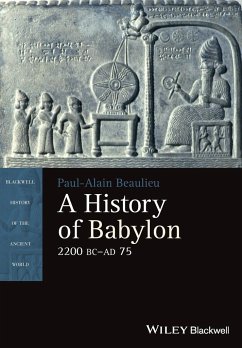Paul-Alain Beaulieu
A History of Babylon, 2200 BC - AD 75
Paul-Alain Beaulieu
A History of Babylon, 2200 BC - AD 75
- Broschiertes Buch
- Merkliste
- Auf die Merkliste
- Bewerten Bewerten
- Teilen
- Produkt teilen
- Produkterinnerung
- Produkterinnerung
During most of its history, Babylon was the capital of a kingdom that corresponded roughly to the southern and central parts of Iraq. This work presents a narrative history of Babylon from the time of its First Dynasty (1880-1595) until the last centuries of the city's existence during the Hellenistic and Parthian periods (ca 331-75 AD).
Andere Kunden interessierten sich auch für
![A History of the Ancient Near East ca. 3000 - 323 BC A History of the Ancient Near East ca. 3000 - 323 BC]() Marc Van De Mieroop (Columbia University and University of Oxford)A History of the Ancient Near East ca. 3000 - 323 BC47,99 €
Marc Van De Mieroop (Columbia University and University of Oxford)A History of the Ancient Near East ca. 3000 - 323 BC47,99 €![Aspects of Roman History 31 BC-AD 117 Aspects of Roman History 31 BC-AD 117]() Richard Alston (Royal Holloway, University of London, UK)Aspects of Roman History 31 BC-AD 11780,99 €
Richard Alston (Royal Holloway, University of London, UK)Aspects of Roman History 31 BC-AD 11780,99 €![The Roman Army at War 100 BC - Ad 200 The Roman Army at War 100 BC - Ad 200]() Adrian Keith Goldsworthy (Research Fellow, Research Fellow, UniversThe Roman Army at War 100 BC - Ad 20069,99 €
Adrian Keith Goldsworthy (Research Fellow, Research Fellow, UniversThe Roman Army at War 100 BC - Ad 20069,99 €![Alexander the Great in the Roman Empire, 150 BC to AD 600 Alexander the Great in the Roman Empire, 150 BC to AD 600]() Jaakkojuhani PeltonenAlexander the Great in the Roman Empire, 150 BC to AD 60045,99 €
Jaakkojuhani PeltonenAlexander the Great in the Roman Empire, 150 BC to AD 60045,99 €![A History of Love and Hate in 21 Statues A History of Love and Hate in 21 Statues]() Peter HughesA History of Love and Hate in 21 Statues16,99 €
Peter HughesA History of Love and Hate in 21 Statues16,99 €![Roman Centurions 31 BC-AD 500 Roman Centurions 31 BC-AD 500]() Raffaele Dâ Amato (Author)Roman Centurions 31 BC-AD 50020,99 €
Raffaele Dâ Amato (Author)Roman Centurions 31 BC-AD 50020,99 €![A History of Love and Hate in 21 Statues A History of Love and Hate in 21 Statues]() Peter HughesA History of Love and Hate in 21 Statues18,99 €
Peter HughesA History of Love and Hate in 21 Statues18,99 €-
-
-
During most of its history, Babylon was the capital of a kingdom that corresponded roughly to the southern and central parts of Iraq. This work presents a narrative history of Babylon from the time of its First Dynasty (1880-1595) until the last centuries of the city's existence during the Hellenistic and Parthian periods (ca 331-75 AD).
Hinweis: Dieser Artikel kann nur an eine deutsche Lieferadresse ausgeliefert werden.
Hinweis: Dieser Artikel kann nur an eine deutsche Lieferadresse ausgeliefert werden.
Produktdetails
- Produktdetails
- Blackwell History of the Ancient World
- Verlag: John Wiley and Sons Ltd
- Seitenzahl: 309
- Erscheinungstermin: 2. Februar 2018
- Englisch
- Abmessung: 244mm x 170mm x 17mm
- Gewicht: 536g
- ISBN-13: 9781405188982
- ISBN-10: 1405188987
- Artikelnr.: 43364682
- Herstellerkennzeichnung
- Libri GmbH
- Europaallee 1
- 36244 Bad Hersfeld
- gpsr@libri.de
- Blackwell History of the Ancient World
- Verlag: John Wiley and Sons Ltd
- Seitenzahl: 309
- Erscheinungstermin: 2. Februar 2018
- Englisch
- Abmessung: 244mm x 170mm x 17mm
- Gewicht: 536g
- ISBN-13: 9781405188982
- ISBN-10: 1405188987
- Artikelnr.: 43364682
- Herstellerkennzeichnung
- Libri GmbH
- Europaallee 1
- 36244 Bad Hersfeld
- gpsr@libri.de
Paul-Alain Beaulieu, PhD, is Professor of Assyriology at the University of Toronto. He is the author of several articles and books on the history and culture of Babylonia, as well as the greater spectrum of Mesopotamian history. He has been teaching Assyriology and Ancient Near Eastern History for more than twenty years.
List of Illustrations xii List of Tables xiv List of Maps xvi Preface xvii List of Abbreviations xix Author's Note xx 1 Introductory Concerns 1 1.1 Assyriology and the Writing of History 3 1.1.1 Cuneiform Texts as Historical Sources 4 1.2 Historical Science and the Handling of Sources 17 1.3 Chronology 20 2 The Sumero
Akkadian Background 24 2.1 Babylonia as Geographic Unit 24 2.2 The Natural Environment 25 2.3 The Neolithic Revolution 28 2.4 The Ubaid Period (6500-4000) 29 2.5 The Uruk Period (4000-3100) 30 2.6 The Jemdet Nasr Period (3100-2900) 31 2.7 The Early Dynastic Period (2900-2350) 34 2.7.1 The State of Lagash 38 2.7.2 Babylon in the Early Dynastic Period 40 2.8 The Sargonic (Old Akkadian) and Gutian Periods (ca. 2334-2113) 41 2.8.1 Akkadian and Sumerian Linguistic Areas 42 2.8.2 The Early Sargonic Period (ca. 2334-2255) 44 2.8.3 The Classical Sargonic Period (ca. 2254-2193) 46 2.8.4 Babylon in the Sargonic Period 50 2.8.5 The Late Sargonic (ca. 2193-2154) and Gutian Periods (ca. 2153-2113) 51 2.9 The Third Dynasty of Ur (2112-2004) 52 2.9.1 King of Sumer and Akkad 53 2.9.2 Shulgi's Babylonia 54 2.9.3 Failure of the Ur III State 56 2.9.4 Babylon during the Ur III Period 57 3 The Rise of Babylon 60 3.1 The First Dynasty of Isin (2017-1794) 62 3.2 The Amorites 64 3.2.1 Amorite Genealogies and Histories 66 3.3 Date Lists and King Lists of Babylon I 68 3.4 Elusive Beginnings 69 3.5 Sumu
läel (1880-1845) 70 3.5.1 The Letter of Anam and the Babylon
Uruk Alliance 71 3.6 Half a Century of Stability (1844-1793) 72 3.6.1 The Battle for Kazallu 74 3.6.2 The Apex of Larsa 75 3.7 Hammu
rabi (1792-1750) 76 3.7.1 In the Shadow of Samsi
Addu (1792-1775) 77 3.7.2 Eshnunna's Bid for Hegemony (1772-1770) 79 3.7.3 A Fragile Equilibrium (1769-1766) 80 3.7.4 The Elamite Intervention and its Aftermath (1766-1764) 82 3.7.5 Showdown with Larsa (1764-1763) 83 3.7.6 The Capture and Sack of Mari (1761-1759) 85 3.7.7 Towards an Empire (1759-1750) 85 3.7.8 The Code of Hammu
rabi 86 3.7.9 Hammu
rabi as Administrator 92 4 Decline of the First Dynasty 97 4.1 The Reign of Samsu
iluna (1749-1712) 97 4.1.1 The Rebellion of Rim
Sin II (1742-1740) 99 4.1.2 The Rebellion of Rim
Anum (1742-1740) 100 4.1.3 The Invasion of the Kassites (1742) 101 4.1.4 Samsu
iluna Strikes Back 101 4.1.5 Sargonic Reveries 102 4.1.6 Loss of Southern Babylonia 103 4.1.7 Northern Exertions 104 4.1.8 Loss of Central Babylonia and Rise of the Sealand 108 4.1.9 From Sumerian to Akkadian Literature 108 4.1.10 Samsu
iluna as Administrator and Legislator 109 4.2 The Last Century of Babylon I (1711-1595) 111 4.2.1 Abi
eshuh (1711-1684) 111 4.2.2 Ammi
ditana (1683-1647) 113 4.2.3 Ammi
saduqa (1646-1626) 114 4.2.4 Samsu
ditana (1625-1595) 117 4.2.5 The City of Babylon during the First Dynasty 119 5 Kassite Ascendancy 122 5.1 The Kassites as Linguistic and Cultural Group 122 5.2 The Early Kassite Period (1595-ca. 1400) 125 5.2.1 The Texts from Tell Muhammad 125 5.2.2 The Early Kassite Rulers (Sixteenth Century) 127 5.2.3 The First Dynasty of the Sealand (ca. 1725-1475) 129 5.2.4 The Reunification of Babylonia 131 5.3 Kassite Babylonia: The Documentary Evidence 132 5.3.1 A New Source: The Kudurrus 133 5.4 Karduniash: A New Babylonia 135 5.4.1 Kurigalzu I 137 5.4.2 Dur
Kurigalzu: A Kassite Royal Residence 137 5.5 The Age of Amarna 140 5.6 The Rise of Assyria 142 5.7 The Middle Kassite Period (1332-1225) 143 5.7.1 Ruralization of Babylonia 145 5.7.2 Nippur as Southern Capital 146 5.8 The Intervention of Tukulti
Ninurta I and its Aftermath 147 5.9 End of the Kassite Regime (1186-1155) 150 5.10 Akkadian Literature under the Kassites 151 6 Second Dynasty of Isin 154 6.1 Marduk and Nabu 157 6.2 Renewed Conflict with Assyria 158 6.3 Nebuchadnezzar I (1121-1100) 159 6.3.1 The Elamite Campaign and the Return of Marduk 159 6.3.2 Enuma Elish and the Supremacy of Marduk 161 6.3.3 Nebuchadnezzar I and Royal Legitimacy 163 6.4 Sealand Memories under Enlil
nadin
apli (1099-1096) 164 6.5 Marduk
nadin
ahhe (1095-1078) 164 6.5.1 Aramean Invasions 167 6.6 Marduk
shapik
zeri (1077-1065) 167 6.7 Adad
apläiddina (1064-1043) 168 6.8 The End of Isin II (1042-1022) 169 7 Arameans and Chaldeans 171 7.1 The Arameans 172 7.2 The Chaldeans 173 7.3 Three Short Dynasties 176 7.4 The Dynasty of E 178 7.4.1 Nabu
mukin
apli (974-939) 179 7.4.2 Assyrian Resurgence 179 7.4.3 Nabu
apläiddina 180 7.4.4 Marduk
zakir
shumi I 182 7.4.5 Descent into Anarchy (819-770?) 183 7.4.6 EribäMarduk 186 7.4.7 Nabu
shumäishkun (760?-748) 186 7.4.8 Nabonassar (747-734) 188 8 The Assyrian Century 193 8.1 The Rebellion of Mukin
zeri 196 8.2 The palû of Baltil (728-722) 197 8.3 Marduk
apläiddina II and Chaldean Resistance (721-709) 198 8.4 The palû of Habigal (709-694) 201 8.5 The Two Shuzubus (694-689) 204 8.6 Sennacherib's Desecration of Babylon (689-681) 206 8.7 Esarhaddon Restores Babylon (681-669) 208 8.7.1 A New Generation of Opponents 209 8.8 Regnant Siblings (669-652) 211 8.9 Civil War (652-648) 214 8.10 Ashurbanipal and Kandalanu (647-630/27) 216 9 Imperial Heyday 219 9.1 Sources 220 9.1.1 Neo
Babylonian Archives 221 9.1.2 Spread of Aramaic 222 9.2 Power Struggle for Babylonia (630-620) 223 9.3 A Chaldeo
Aramean Empire 224 9.4 The Fall of Assyria (616-609) 225 9.5 Nabopolassar and the Restoration of Babylonia 227 9.6 Nebuchadnezzar in the Levant 227 9.7 The Climax of Babylon 229 9.7.1 Economic Expansion 232 9.7.2 Administration of Babylonia 233 9.7.3 Methods of Imperial Control 235 9.8 A Problematic Succession (562-556) 237 9.9 Babylon's Twilight: The Reign of Nabonidus (555-539) 238 9.9.1 The Conquest of North Arabia 239 9.9.2 Geopolitical Upheaval 240 9.9.3 The Last Days of Imperial Babylon 243 10 Babylon under Foreign Rule 246 10.1 Cyrus Enters Babylon 247 10.2 A Smooth Transition 248 10.3 The Babylonian Pretenders of 522-521 250 10.4 The Reforms of Darius I 251 10.5 The Babylonian Pretenders of 484 253 10.6 Babylonia in the Late Achaemenid Period 254 10.7 Hellenistic Babylonia 256 10.8 Alexander and his Successors in Babylon (331-311) 257 10.9 Babylon and Seleucia 259 10.10 An Age of Renewal 261 10.11 Hellenization of Babylonia 263 10.12 Parthian Takeover 265 10.13 Sic Transit 266 Appendix: Checklist of Chronicles 269 Bibliography 271 Index 273
Akkadian Background 24 2.1 Babylonia as Geographic Unit 24 2.2 The Natural Environment 25 2.3 The Neolithic Revolution 28 2.4 The Ubaid Period (6500-4000) 29 2.5 The Uruk Period (4000-3100) 30 2.6 The Jemdet Nasr Period (3100-2900) 31 2.7 The Early Dynastic Period (2900-2350) 34 2.7.1 The State of Lagash 38 2.7.2 Babylon in the Early Dynastic Period 40 2.8 The Sargonic (Old Akkadian) and Gutian Periods (ca. 2334-2113) 41 2.8.1 Akkadian and Sumerian Linguistic Areas 42 2.8.2 The Early Sargonic Period (ca. 2334-2255) 44 2.8.3 The Classical Sargonic Period (ca. 2254-2193) 46 2.8.4 Babylon in the Sargonic Period 50 2.8.5 The Late Sargonic (ca. 2193-2154) and Gutian Periods (ca. 2153-2113) 51 2.9 The Third Dynasty of Ur (2112-2004) 52 2.9.1 King of Sumer and Akkad 53 2.9.2 Shulgi's Babylonia 54 2.9.3 Failure of the Ur III State 56 2.9.4 Babylon during the Ur III Period 57 3 The Rise of Babylon 60 3.1 The First Dynasty of Isin (2017-1794) 62 3.2 The Amorites 64 3.2.1 Amorite Genealogies and Histories 66 3.3 Date Lists and King Lists of Babylon I 68 3.4 Elusive Beginnings 69 3.5 Sumu
läel (1880-1845) 70 3.5.1 The Letter of Anam and the Babylon
Uruk Alliance 71 3.6 Half a Century of Stability (1844-1793) 72 3.6.1 The Battle for Kazallu 74 3.6.2 The Apex of Larsa 75 3.7 Hammu
rabi (1792-1750) 76 3.7.1 In the Shadow of Samsi
Addu (1792-1775) 77 3.7.2 Eshnunna's Bid for Hegemony (1772-1770) 79 3.7.3 A Fragile Equilibrium (1769-1766) 80 3.7.4 The Elamite Intervention and its Aftermath (1766-1764) 82 3.7.5 Showdown with Larsa (1764-1763) 83 3.7.6 The Capture and Sack of Mari (1761-1759) 85 3.7.7 Towards an Empire (1759-1750) 85 3.7.8 The Code of Hammu
rabi 86 3.7.9 Hammu
rabi as Administrator 92 4 Decline of the First Dynasty 97 4.1 The Reign of Samsu
iluna (1749-1712) 97 4.1.1 The Rebellion of Rim
Sin II (1742-1740) 99 4.1.2 The Rebellion of Rim
Anum (1742-1740) 100 4.1.3 The Invasion of the Kassites (1742) 101 4.1.4 Samsu
iluna Strikes Back 101 4.1.5 Sargonic Reveries 102 4.1.6 Loss of Southern Babylonia 103 4.1.7 Northern Exertions 104 4.1.8 Loss of Central Babylonia and Rise of the Sealand 108 4.1.9 From Sumerian to Akkadian Literature 108 4.1.10 Samsu
iluna as Administrator and Legislator 109 4.2 The Last Century of Babylon I (1711-1595) 111 4.2.1 Abi
eshuh (1711-1684) 111 4.2.2 Ammi
ditana (1683-1647) 113 4.2.3 Ammi
saduqa (1646-1626) 114 4.2.4 Samsu
ditana (1625-1595) 117 4.2.5 The City of Babylon during the First Dynasty 119 5 Kassite Ascendancy 122 5.1 The Kassites as Linguistic and Cultural Group 122 5.2 The Early Kassite Period (1595-ca. 1400) 125 5.2.1 The Texts from Tell Muhammad 125 5.2.2 The Early Kassite Rulers (Sixteenth Century) 127 5.2.3 The First Dynasty of the Sealand (ca. 1725-1475) 129 5.2.4 The Reunification of Babylonia 131 5.3 Kassite Babylonia: The Documentary Evidence 132 5.3.1 A New Source: The Kudurrus 133 5.4 Karduniash: A New Babylonia 135 5.4.1 Kurigalzu I 137 5.4.2 Dur
Kurigalzu: A Kassite Royal Residence 137 5.5 The Age of Amarna 140 5.6 The Rise of Assyria 142 5.7 The Middle Kassite Period (1332-1225) 143 5.7.1 Ruralization of Babylonia 145 5.7.2 Nippur as Southern Capital 146 5.8 The Intervention of Tukulti
Ninurta I and its Aftermath 147 5.9 End of the Kassite Regime (1186-1155) 150 5.10 Akkadian Literature under the Kassites 151 6 Second Dynasty of Isin 154 6.1 Marduk and Nabu 157 6.2 Renewed Conflict with Assyria 158 6.3 Nebuchadnezzar I (1121-1100) 159 6.3.1 The Elamite Campaign and the Return of Marduk 159 6.3.2 Enuma Elish and the Supremacy of Marduk 161 6.3.3 Nebuchadnezzar I and Royal Legitimacy 163 6.4 Sealand Memories under Enlil
nadin
apli (1099-1096) 164 6.5 Marduk
nadin
ahhe (1095-1078) 164 6.5.1 Aramean Invasions 167 6.6 Marduk
shapik
zeri (1077-1065) 167 6.7 Adad
apläiddina (1064-1043) 168 6.8 The End of Isin II (1042-1022) 169 7 Arameans and Chaldeans 171 7.1 The Arameans 172 7.2 The Chaldeans 173 7.3 Three Short Dynasties 176 7.4 The Dynasty of E 178 7.4.1 Nabu
mukin
apli (974-939) 179 7.4.2 Assyrian Resurgence 179 7.4.3 Nabu
apläiddina 180 7.4.4 Marduk
zakir
shumi I 182 7.4.5 Descent into Anarchy (819-770?) 183 7.4.6 EribäMarduk 186 7.4.7 Nabu
shumäishkun (760?-748) 186 7.4.8 Nabonassar (747-734) 188 8 The Assyrian Century 193 8.1 The Rebellion of Mukin
zeri 196 8.2 The palû of Baltil (728-722) 197 8.3 Marduk
apläiddina II and Chaldean Resistance (721-709) 198 8.4 The palû of Habigal (709-694) 201 8.5 The Two Shuzubus (694-689) 204 8.6 Sennacherib's Desecration of Babylon (689-681) 206 8.7 Esarhaddon Restores Babylon (681-669) 208 8.7.1 A New Generation of Opponents 209 8.8 Regnant Siblings (669-652) 211 8.9 Civil War (652-648) 214 8.10 Ashurbanipal and Kandalanu (647-630/27) 216 9 Imperial Heyday 219 9.1 Sources 220 9.1.1 Neo
Babylonian Archives 221 9.1.2 Spread of Aramaic 222 9.2 Power Struggle for Babylonia (630-620) 223 9.3 A Chaldeo
Aramean Empire 224 9.4 The Fall of Assyria (616-609) 225 9.5 Nabopolassar and the Restoration of Babylonia 227 9.6 Nebuchadnezzar in the Levant 227 9.7 The Climax of Babylon 229 9.7.1 Economic Expansion 232 9.7.2 Administration of Babylonia 233 9.7.3 Methods of Imperial Control 235 9.8 A Problematic Succession (562-556) 237 9.9 Babylon's Twilight: The Reign of Nabonidus (555-539) 238 9.9.1 The Conquest of North Arabia 239 9.9.2 Geopolitical Upheaval 240 9.9.3 The Last Days of Imperial Babylon 243 10 Babylon under Foreign Rule 246 10.1 Cyrus Enters Babylon 247 10.2 A Smooth Transition 248 10.3 The Babylonian Pretenders of 522-521 250 10.4 The Reforms of Darius I 251 10.5 The Babylonian Pretenders of 484 253 10.6 Babylonia in the Late Achaemenid Period 254 10.7 Hellenistic Babylonia 256 10.8 Alexander and his Successors in Babylon (331-311) 257 10.9 Babylon and Seleucia 259 10.10 An Age of Renewal 261 10.11 Hellenization of Babylonia 263 10.12 Parthian Takeover 265 10.13 Sic Transit 266 Appendix: Checklist of Chronicles 269 Bibliography 271 Index 273
List of Illustrations xii List of Tables xiv List of Maps xvi Preface xvii List of Abbreviations xix Author's Note xx 1 Introductory Concerns 1 1.1 Assyriology and the Writing of History 3 1.1.1 Cuneiform Texts as Historical Sources 4 1.2 Historical Science and the Handling of Sources 17 1.3 Chronology 20 2 The Sumero
Akkadian Background 24 2.1 Babylonia as Geographic Unit 24 2.2 The Natural Environment 25 2.3 The Neolithic Revolution 28 2.4 The Ubaid Period (6500-4000) 29 2.5 The Uruk Period (4000-3100) 30 2.6 The Jemdet Nasr Period (3100-2900) 31 2.7 The Early Dynastic Period (2900-2350) 34 2.7.1 The State of Lagash 38 2.7.2 Babylon in the Early Dynastic Period 40 2.8 The Sargonic (Old Akkadian) and Gutian Periods (ca. 2334-2113) 41 2.8.1 Akkadian and Sumerian Linguistic Areas 42 2.8.2 The Early Sargonic Period (ca. 2334-2255) 44 2.8.3 The Classical Sargonic Period (ca. 2254-2193) 46 2.8.4 Babylon in the Sargonic Period 50 2.8.5 The Late Sargonic (ca. 2193-2154) and Gutian Periods (ca. 2153-2113) 51 2.9 The Third Dynasty of Ur (2112-2004) 52 2.9.1 King of Sumer and Akkad 53 2.9.2 Shulgi's Babylonia 54 2.9.3 Failure of the Ur III State 56 2.9.4 Babylon during the Ur III Period 57 3 The Rise of Babylon 60 3.1 The First Dynasty of Isin (2017-1794) 62 3.2 The Amorites 64 3.2.1 Amorite Genealogies and Histories 66 3.3 Date Lists and King Lists of Babylon I 68 3.4 Elusive Beginnings 69 3.5 Sumu
läel (1880-1845) 70 3.5.1 The Letter of Anam and the Babylon
Uruk Alliance 71 3.6 Half a Century of Stability (1844-1793) 72 3.6.1 The Battle for Kazallu 74 3.6.2 The Apex of Larsa 75 3.7 Hammu
rabi (1792-1750) 76 3.7.1 In the Shadow of Samsi
Addu (1792-1775) 77 3.7.2 Eshnunna's Bid for Hegemony (1772-1770) 79 3.7.3 A Fragile Equilibrium (1769-1766) 80 3.7.4 The Elamite Intervention and its Aftermath (1766-1764) 82 3.7.5 Showdown with Larsa (1764-1763) 83 3.7.6 The Capture and Sack of Mari (1761-1759) 85 3.7.7 Towards an Empire (1759-1750) 85 3.7.8 The Code of Hammu
rabi 86 3.7.9 Hammu
rabi as Administrator 92 4 Decline of the First Dynasty 97 4.1 The Reign of Samsu
iluna (1749-1712) 97 4.1.1 The Rebellion of Rim
Sin II (1742-1740) 99 4.1.2 The Rebellion of Rim
Anum (1742-1740) 100 4.1.3 The Invasion of the Kassites (1742) 101 4.1.4 Samsu
iluna Strikes Back 101 4.1.5 Sargonic Reveries 102 4.1.6 Loss of Southern Babylonia 103 4.1.7 Northern Exertions 104 4.1.8 Loss of Central Babylonia and Rise of the Sealand 108 4.1.9 From Sumerian to Akkadian Literature 108 4.1.10 Samsu
iluna as Administrator and Legislator 109 4.2 The Last Century of Babylon I (1711-1595) 111 4.2.1 Abi
eshuh (1711-1684) 111 4.2.2 Ammi
ditana (1683-1647) 113 4.2.3 Ammi
saduqa (1646-1626) 114 4.2.4 Samsu
ditana (1625-1595) 117 4.2.5 The City of Babylon during the First Dynasty 119 5 Kassite Ascendancy 122 5.1 The Kassites as Linguistic and Cultural Group 122 5.2 The Early Kassite Period (1595-ca. 1400) 125 5.2.1 The Texts from Tell Muhammad 125 5.2.2 The Early Kassite Rulers (Sixteenth Century) 127 5.2.3 The First Dynasty of the Sealand (ca. 1725-1475) 129 5.2.4 The Reunification of Babylonia 131 5.3 Kassite Babylonia: The Documentary Evidence 132 5.3.1 A New Source: The Kudurrus 133 5.4 Karduniash: A New Babylonia 135 5.4.1 Kurigalzu I 137 5.4.2 Dur
Kurigalzu: A Kassite Royal Residence 137 5.5 The Age of Amarna 140 5.6 The Rise of Assyria 142 5.7 The Middle Kassite Period (1332-1225) 143 5.7.1 Ruralization of Babylonia 145 5.7.2 Nippur as Southern Capital 146 5.8 The Intervention of Tukulti
Ninurta I and its Aftermath 147 5.9 End of the Kassite Regime (1186-1155) 150 5.10 Akkadian Literature under the Kassites 151 6 Second Dynasty of Isin 154 6.1 Marduk and Nabu 157 6.2 Renewed Conflict with Assyria 158 6.3 Nebuchadnezzar I (1121-1100) 159 6.3.1 The Elamite Campaign and the Return of Marduk 159 6.3.2 Enuma Elish and the Supremacy of Marduk 161 6.3.3 Nebuchadnezzar I and Royal Legitimacy 163 6.4 Sealand Memories under Enlil
nadin
apli (1099-1096) 164 6.5 Marduk
nadin
ahhe (1095-1078) 164 6.5.1 Aramean Invasions 167 6.6 Marduk
shapik
zeri (1077-1065) 167 6.7 Adad
apläiddina (1064-1043) 168 6.8 The End of Isin II (1042-1022) 169 7 Arameans and Chaldeans 171 7.1 The Arameans 172 7.2 The Chaldeans 173 7.3 Three Short Dynasties 176 7.4 The Dynasty of E 178 7.4.1 Nabu
mukin
apli (974-939) 179 7.4.2 Assyrian Resurgence 179 7.4.3 Nabu
apläiddina 180 7.4.4 Marduk
zakir
shumi I 182 7.4.5 Descent into Anarchy (819-770?) 183 7.4.6 EribäMarduk 186 7.4.7 Nabu
shumäishkun (760?-748) 186 7.4.8 Nabonassar (747-734) 188 8 The Assyrian Century 193 8.1 The Rebellion of Mukin
zeri 196 8.2 The palû of Baltil (728-722) 197 8.3 Marduk
apläiddina II and Chaldean Resistance (721-709) 198 8.4 The palû of Habigal (709-694) 201 8.5 The Two Shuzubus (694-689) 204 8.6 Sennacherib's Desecration of Babylon (689-681) 206 8.7 Esarhaddon Restores Babylon (681-669) 208 8.7.1 A New Generation of Opponents 209 8.8 Regnant Siblings (669-652) 211 8.9 Civil War (652-648) 214 8.10 Ashurbanipal and Kandalanu (647-630/27) 216 9 Imperial Heyday 219 9.1 Sources 220 9.1.1 Neo
Babylonian Archives 221 9.1.2 Spread of Aramaic 222 9.2 Power Struggle for Babylonia (630-620) 223 9.3 A Chaldeo
Aramean Empire 224 9.4 The Fall of Assyria (616-609) 225 9.5 Nabopolassar and the Restoration of Babylonia 227 9.6 Nebuchadnezzar in the Levant 227 9.7 The Climax of Babylon 229 9.7.1 Economic Expansion 232 9.7.2 Administration of Babylonia 233 9.7.3 Methods of Imperial Control 235 9.8 A Problematic Succession (562-556) 237 9.9 Babylon's Twilight: The Reign of Nabonidus (555-539) 238 9.9.1 The Conquest of North Arabia 239 9.9.2 Geopolitical Upheaval 240 9.9.3 The Last Days of Imperial Babylon 243 10 Babylon under Foreign Rule 246 10.1 Cyrus Enters Babylon 247 10.2 A Smooth Transition 248 10.3 The Babylonian Pretenders of 522-521 250 10.4 The Reforms of Darius I 251 10.5 The Babylonian Pretenders of 484 253 10.6 Babylonia in the Late Achaemenid Period 254 10.7 Hellenistic Babylonia 256 10.8 Alexander and his Successors in Babylon (331-311) 257 10.9 Babylon and Seleucia 259 10.10 An Age of Renewal 261 10.11 Hellenization of Babylonia 263 10.12 Parthian Takeover 265 10.13 Sic Transit 266 Appendix: Checklist of Chronicles 269 Bibliography 271 Index 273
Akkadian Background 24 2.1 Babylonia as Geographic Unit 24 2.2 The Natural Environment 25 2.3 The Neolithic Revolution 28 2.4 The Ubaid Period (6500-4000) 29 2.5 The Uruk Period (4000-3100) 30 2.6 The Jemdet Nasr Period (3100-2900) 31 2.7 The Early Dynastic Period (2900-2350) 34 2.7.1 The State of Lagash 38 2.7.2 Babylon in the Early Dynastic Period 40 2.8 The Sargonic (Old Akkadian) and Gutian Periods (ca. 2334-2113) 41 2.8.1 Akkadian and Sumerian Linguistic Areas 42 2.8.2 The Early Sargonic Period (ca. 2334-2255) 44 2.8.3 The Classical Sargonic Period (ca. 2254-2193) 46 2.8.4 Babylon in the Sargonic Period 50 2.8.5 The Late Sargonic (ca. 2193-2154) and Gutian Periods (ca. 2153-2113) 51 2.9 The Third Dynasty of Ur (2112-2004) 52 2.9.1 King of Sumer and Akkad 53 2.9.2 Shulgi's Babylonia 54 2.9.3 Failure of the Ur III State 56 2.9.4 Babylon during the Ur III Period 57 3 The Rise of Babylon 60 3.1 The First Dynasty of Isin (2017-1794) 62 3.2 The Amorites 64 3.2.1 Amorite Genealogies and Histories 66 3.3 Date Lists and King Lists of Babylon I 68 3.4 Elusive Beginnings 69 3.5 Sumu
läel (1880-1845) 70 3.5.1 The Letter of Anam and the Babylon
Uruk Alliance 71 3.6 Half a Century of Stability (1844-1793) 72 3.6.1 The Battle for Kazallu 74 3.6.2 The Apex of Larsa 75 3.7 Hammu
rabi (1792-1750) 76 3.7.1 In the Shadow of Samsi
Addu (1792-1775) 77 3.7.2 Eshnunna's Bid for Hegemony (1772-1770) 79 3.7.3 A Fragile Equilibrium (1769-1766) 80 3.7.4 The Elamite Intervention and its Aftermath (1766-1764) 82 3.7.5 Showdown with Larsa (1764-1763) 83 3.7.6 The Capture and Sack of Mari (1761-1759) 85 3.7.7 Towards an Empire (1759-1750) 85 3.7.8 The Code of Hammu
rabi 86 3.7.9 Hammu
rabi as Administrator 92 4 Decline of the First Dynasty 97 4.1 The Reign of Samsu
iluna (1749-1712) 97 4.1.1 The Rebellion of Rim
Sin II (1742-1740) 99 4.1.2 The Rebellion of Rim
Anum (1742-1740) 100 4.1.3 The Invasion of the Kassites (1742) 101 4.1.4 Samsu
iluna Strikes Back 101 4.1.5 Sargonic Reveries 102 4.1.6 Loss of Southern Babylonia 103 4.1.7 Northern Exertions 104 4.1.8 Loss of Central Babylonia and Rise of the Sealand 108 4.1.9 From Sumerian to Akkadian Literature 108 4.1.10 Samsu
iluna as Administrator and Legislator 109 4.2 The Last Century of Babylon I (1711-1595) 111 4.2.1 Abi
eshuh (1711-1684) 111 4.2.2 Ammi
ditana (1683-1647) 113 4.2.3 Ammi
saduqa (1646-1626) 114 4.2.4 Samsu
ditana (1625-1595) 117 4.2.5 The City of Babylon during the First Dynasty 119 5 Kassite Ascendancy 122 5.1 The Kassites as Linguistic and Cultural Group 122 5.2 The Early Kassite Period (1595-ca. 1400) 125 5.2.1 The Texts from Tell Muhammad 125 5.2.2 The Early Kassite Rulers (Sixteenth Century) 127 5.2.3 The First Dynasty of the Sealand (ca. 1725-1475) 129 5.2.4 The Reunification of Babylonia 131 5.3 Kassite Babylonia: The Documentary Evidence 132 5.3.1 A New Source: The Kudurrus 133 5.4 Karduniash: A New Babylonia 135 5.4.1 Kurigalzu I 137 5.4.2 Dur
Kurigalzu: A Kassite Royal Residence 137 5.5 The Age of Amarna 140 5.6 The Rise of Assyria 142 5.7 The Middle Kassite Period (1332-1225) 143 5.7.1 Ruralization of Babylonia 145 5.7.2 Nippur as Southern Capital 146 5.8 The Intervention of Tukulti
Ninurta I and its Aftermath 147 5.9 End of the Kassite Regime (1186-1155) 150 5.10 Akkadian Literature under the Kassites 151 6 Second Dynasty of Isin 154 6.1 Marduk and Nabu 157 6.2 Renewed Conflict with Assyria 158 6.3 Nebuchadnezzar I (1121-1100) 159 6.3.1 The Elamite Campaign and the Return of Marduk 159 6.3.2 Enuma Elish and the Supremacy of Marduk 161 6.3.3 Nebuchadnezzar I and Royal Legitimacy 163 6.4 Sealand Memories under Enlil
nadin
apli (1099-1096) 164 6.5 Marduk
nadin
ahhe (1095-1078) 164 6.5.1 Aramean Invasions 167 6.6 Marduk
shapik
zeri (1077-1065) 167 6.7 Adad
apläiddina (1064-1043) 168 6.8 The End of Isin II (1042-1022) 169 7 Arameans and Chaldeans 171 7.1 The Arameans 172 7.2 The Chaldeans 173 7.3 Three Short Dynasties 176 7.4 The Dynasty of E 178 7.4.1 Nabu
mukin
apli (974-939) 179 7.4.2 Assyrian Resurgence 179 7.4.3 Nabu
apläiddina 180 7.4.4 Marduk
zakir
shumi I 182 7.4.5 Descent into Anarchy (819-770?) 183 7.4.6 EribäMarduk 186 7.4.7 Nabu
shumäishkun (760?-748) 186 7.4.8 Nabonassar (747-734) 188 8 The Assyrian Century 193 8.1 The Rebellion of Mukin
zeri 196 8.2 The palû of Baltil (728-722) 197 8.3 Marduk
apläiddina II and Chaldean Resistance (721-709) 198 8.4 The palû of Habigal (709-694) 201 8.5 The Two Shuzubus (694-689) 204 8.6 Sennacherib's Desecration of Babylon (689-681) 206 8.7 Esarhaddon Restores Babylon (681-669) 208 8.7.1 A New Generation of Opponents 209 8.8 Regnant Siblings (669-652) 211 8.9 Civil War (652-648) 214 8.10 Ashurbanipal and Kandalanu (647-630/27) 216 9 Imperial Heyday 219 9.1 Sources 220 9.1.1 Neo
Babylonian Archives 221 9.1.2 Spread of Aramaic 222 9.2 Power Struggle for Babylonia (630-620) 223 9.3 A Chaldeo
Aramean Empire 224 9.4 The Fall of Assyria (616-609) 225 9.5 Nabopolassar and the Restoration of Babylonia 227 9.6 Nebuchadnezzar in the Levant 227 9.7 The Climax of Babylon 229 9.7.1 Economic Expansion 232 9.7.2 Administration of Babylonia 233 9.7.3 Methods of Imperial Control 235 9.8 A Problematic Succession (562-556) 237 9.9 Babylon's Twilight: The Reign of Nabonidus (555-539) 238 9.9.1 The Conquest of North Arabia 239 9.9.2 Geopolitical Upheaval 240 9.9.3 The Last Days of Imperial Babylon 243 10 Babylon under Foreign Rule 246 10.1 Cyrus Enters Babylon 247 10.2 A Smooth Transition 248 10.3 The Babylonian Pretenders of 522-521 250 10.4 The Reforms of Darius I 251 10.5 The Babylonian Pretenders of 484 253 10.6 Babylonia in the Late Achaemenid Period 254 10.7 Hellenistic Babylonia 256 10.8 Alexander and his Successors in Babylon (331-311) 257 10.9 Babylon and Seleucia 259 10.10 An Age of Renewal 261 10.11 Hellenization of Babylonia 263 10.12 Parthian Takeover 265 10.13 Sic Transit 266 Appendix: Checklist of Chronicles 269 Bibliography 271 Index 273








